Health Settings in Universities
This paper discusses the development of healthy settings, its origin and transition, and its application to universities. It explores the challenges and opportunities in implementing the settings approach to universities.
22 Pages5685 Words36 Views
Added on 2022-09-02
Health Settings in Universities
This paper discusses the development of healthy settings, its origin and transition, and its application to universities. It explores the challenges and opportunities in implementing the settings approach to universities.
Added on 2022-09-02
ShareRelated Documents
Running Head: HEALTHY SETTINGS
HEALTH SETTINGS IN UNIVERSITIES
Name of the Student
Name of the University
Author’s Note
HEALTH SETTINGS IN UNIVERSITIES
Name of the Student
Name of the University
Author’s Note
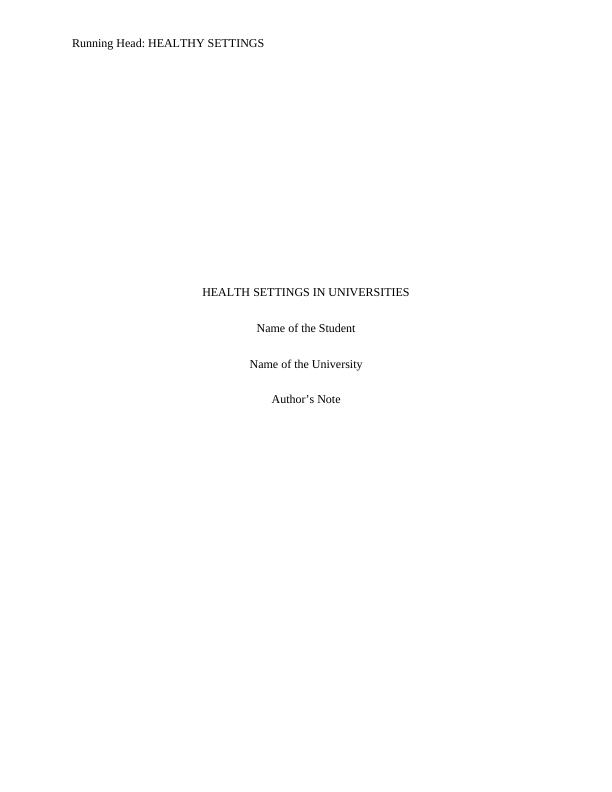
HEALTHY SETTINGS1
Introduction
‘Healthy settings’ is a movement that was started by the World Health Organization due
to the WHO strategy of Health for All in 1980. This report will highlight the benefits of a green
and healthy future, developing a healthy place specifically a healthy university, imaging and
mapping of settings that is needed for everyday life. It will also differentiate between health in a
setting and a healthy setting, the international perspective about healthy setting and the critical
reflection about the theory of healthy setting will be given including the new ventures this topic
has the potential to explore. A green and healthy future is sustainable and healthy in the longer
run because it is done for the benefit of all. Globalization is linked with consumer culture, which
is devastating for the environment because it is the reason for climate change, social
determinants, health inequality and issues in public health settings (Dooris, 2004). It will be
focusing on healthy settings in universities and how WHO has initiated their help and
corporation in the sustainability in universities and educational settings. In the last few years
there has been an innovation and change in the idea of healthcare approaches in society and
educational settings due to a number of factors such as new technology, awareness about
unhealthy environment, environmental degradation and increasing health complications. A
healthy future is more attractive to the consumers due to many advantages such a healthy
standard of living, public health facilities, sustainability, and better prospect for the future
(Dooris, 2009). The opportunities and the upcoming challenges are another aspect that needs to
be given importance because of the development and ongoing rise in this field. Every individual
has the right to live in a healthy and sustainable environment so that they can live in a positive
background without stressing about the future resources (Dooris, 2016). Healthy setting
approach is appreciative of the health determinants that are operated in the settings of the
Introduction
‘Healthy settings’ is a movement that was started by the World Health Organization due
to the WHO strategy of Health for All in 1980. This report will highlight the benefits of a green
and healthy future, developing a healthy place specifically a healthy university, imaging and
mapping of settings that is needed for everyday life. It will also differentiate between health in a
setting and a healthy setting, the international perspective about healthy setting and the critical
reflection about the theory of healthy setting will be given including the new ventures this topic
has the potential to explore. A green and healthy future is sustainable and healthy in the longer
run because it is done for the benefit of all. Globalization is linked with consumer culture, which
is devastating for the environment because it is the reason for climate change, social
determinants, health inequality and issues in public health settings (Dooris, 2004). It will be
focusing on healthy settings in universities and how WHO has initiated their help and
corporation in the sustainability in universities and educational settings. In the last few years
there has been an innovation and change in the idea of healthcare approaches in society and
educational settings due to a number of factors such as new technology, awareness about
unhealthy environment, environmental degradation and increasing health complications. A
healthy future is more attractive to the consumers due to many advantages such a healthy
standard of living, public health facilities, sustainability, and better prospect for the future
(Dooris, 2009). The opportunities and the upcoming challenges are another aspect that needs to
be given importance because of the development and ongoing rise in this field. Every individual
has the right to live in a healthy and sustainable environment so that they can live in a positive
background without stressing about the future resources (Dooris, 2016). Healthy setting
approach is appreciative of the health determinants that are operated in the settings of the

HEALTHY SETTINGS2
everyday life. In our everyday life, a number of factors become relevant for our wellbeing so it
requires the imaging and mapping of setting, so the future responses can be beneficial for the
upcoming generation.
Fig. 1. A Healthy Setting approach (Doherty & Dooris, 2006).
The healthy setting approach has been acknowledged internationally because it is
applicable and well known by many international organization. As it is a strategy by WHO, it is
well known all around the world and has been taken as a positive outcome. Contemporary
promotions of health consist of several social interventions that are slotted into intentional
changing of efforts in the contexts that are pre-existing (Poland, Green & Rootman, 2000). Many
conceptual frameworks and principles have been used by researchers and health workers to
include research, policy and practice. Seven conceptual frameworks of theoretical perspectives
were proposed such as the Ottawa Charter, salutogenesis, a socio-ecological approach (which is
everyday life. In our everyday life, a number of factors become relevant for our wellbeing so it
requires the imaging and mapping of setting, so the future responses can be beneficial for the
upcoming generation.
Fig. 1. A Healthy Setting approach (Doherty & Dooris, 2006).
The healthy setting approach has been acknowledged internationally because it is
applicable and well known by many international organization. As it is a strategy by WHO, it is
well known all around the world and has been taken as a positive outcome. Contemporary
promotions of health consist of several social interventions that are slotted into intentional
changing of efforts in the contexts that are pre-existing (Poland, Green & Rootman, 2000). Many
conceptual frameworks and principles have been used by researchers and health workers to
include research, policy and practice. Seven conceptual frameworks of theoretical perspectives
were proposed such as the Ottawa Charter, salutogenesis, a socio-ecological approach (which is
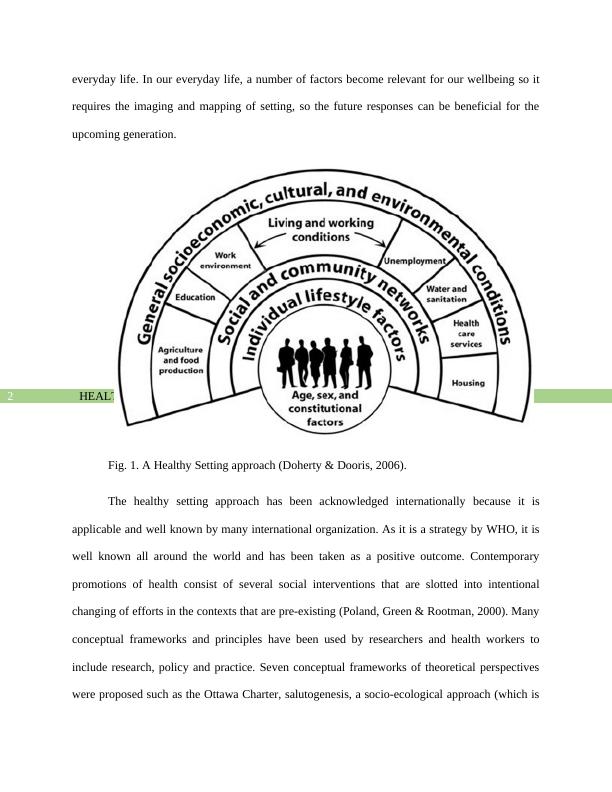
HEALTHY SETTINGS3
based on structure and agency with the help of sociological theories), whole system change,
organizational development, Dooris’s framework and systems thinking. The approach of healthy
settings in universities has a holistic approach to health, includes the whole university’s
requirements and facilities with the organizational culture and wellbeing of the youth (Scriven
and Hodgins, 2011).
Discussion
World Health Organization (WHO) defines health as a state of complete mental, social
and physical wellbeing and not only the absence of disease or infirmity. This definition was
coined in the year of 1946 as identified in the preamble of WHO constitution. The implication
and relevance of health is essential because it affects the wellbeing of the entire global
population. The implications of health is the ‘ability to adapt and self-manage’ in the aspect of
positive wellbeing and sustainability in the long run. The relevance of health is the wellbeing of
an individual in every parameters that helps them live a physically, socially and emotionally
positive environment. A good health includes a balanced diet, intervention of physical activities
and the recommended amount of sleep, which increases the chances of improving our health.
WHO has been promoting health because it is their major objective as an organization
that is known internationally, and is useful for several health interventions for the vulnerable
groups. A new health promotion has been started by WHO that focuses on health promotions in
schools. The name of the health initiative is “Making Every School a Health Promoting School”
and it will be developed through the promotion of Global Standards for Health Promoting
schools and it will serve more than 2.3 billion school age children that includes contributing to
WHO’s 13th General Programme of Work. This also aims towards achieving the target of ‘1
billion lives made easier’ by 2023 (Poland, Dooris & Haluza-Delay, 2011).
based on structure and agency with the help of sociological theories), whole system change,
organizational development, Dooris’s framework and systems thinking. The approach of healthy
settings in universities has a holistic approach to health, includes the whole university’s
requirements and facilities with the organizational culture and wellbeing of the youth (Scriven
and Hodgins, 2011).
Discussion
World Health Organization (WHO) defines health as a state of complete mental, social
and physical wellbeing and not only the absence of disease or infirmity. This definition was
coined in the year of 1946 as identified in the preamble of WHO constitution. The implication
and relevance of health is essential because it affects the wellbeing of the entire global
population. The implications of health is the ‘ability to adapt and self-manage’ in the aspect of
positive wellbeing and sustainability in the long run. The relevance of health is the wellbeing of
an individual in every parameters that helps them live a physically, socially and emotionally
positive environment. A good health includes a balanced diet, intervention of physical activities
and the recommended amount of sleep, which increases the chances of improving our health.
WHO has been promoting health because it is their major objective as an organization
that is known internationally, and is useful for several health interventions for the vulnerable
groups. A new health promotion has been started by WHO that focuses on health promotions in
schools. The name of the health initiative is “Making Every School a Health Promoting School”
and it will be developed through the promotion of Global Standards for Health Promoting
schools and it will serve more than 2.3 billion school age children that includes contributing to
WHO’s 13th General Programme of Work. This also aims towards achieving the target of ‘1
billion lives made easier’ by 2023 (Poland, Dooris & Haluza-Delay, 2011).
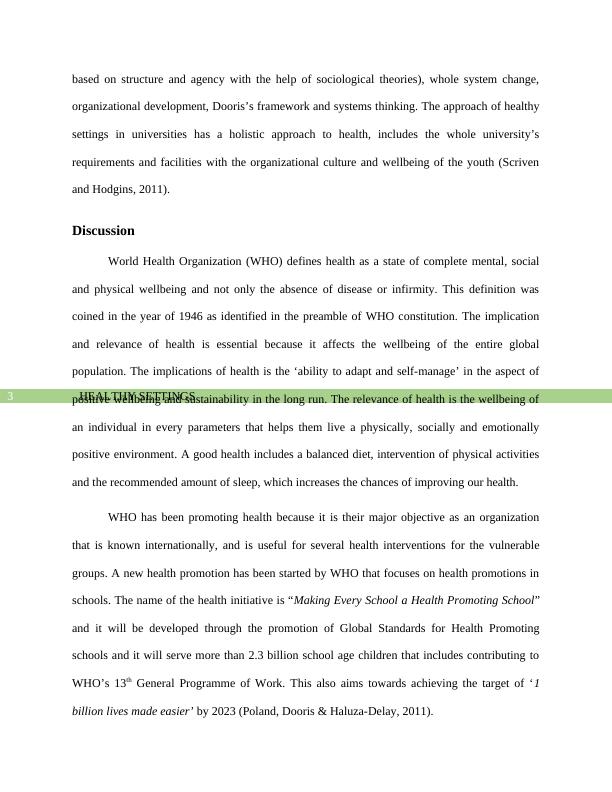
HEALTHY SETTINGS4
A setting is a scenario, manner or position that is set and the working or the framework is
implemented with the help of the particular setting. Sometimes the time, place and the
circumstances are set for something to develop or occur. “Health is created and lived by people
within the settings of their everyday life; where they learn, work, play, and love” as written in
The Ottawa Charter (1986) (World Health Organisation, 1986).
Fig 2. The Ottawa Charter (Dooris, 2012).
The health setting is an approach that is based on health promotions and influencing more
acts of healthy living, and the Healthy Cities Programme is the best initiative for a successful
Healthy Settings programme. The concept of sustainability has been prevailing from a long time
and it has been a part of history in local, national and international levels. This concept emerged
through the idea of growing awareness because of several ecological crisis in the 20thy century.
A setting is a scenario, manner or position that is set and the working or the framework is
implemented with the help of the particular setting. Sometimes the time, place and the
circumstances are set for something to develop or occur. “Health is created and lived by people
within the settings of their everyday life; where they learn, work, play, and love” as written in
The Ottawa Charter (1986) (World Health Organisation, 1986).
Fig 2. The Ottawa Charter (Dooris, 2012).
The health setting is an approach that is based on health promotions and influencing more
acts of healthy living, and the Healthy Cities Programme is the best initiative for a successful
Healthy Settings programme. The concept of sustainability has been prevailing from a long time
and it has been a part of history in local, national and international levels. This concept emerged
through the idea of growing awareness because of several ecological crisis in the 20thy century.
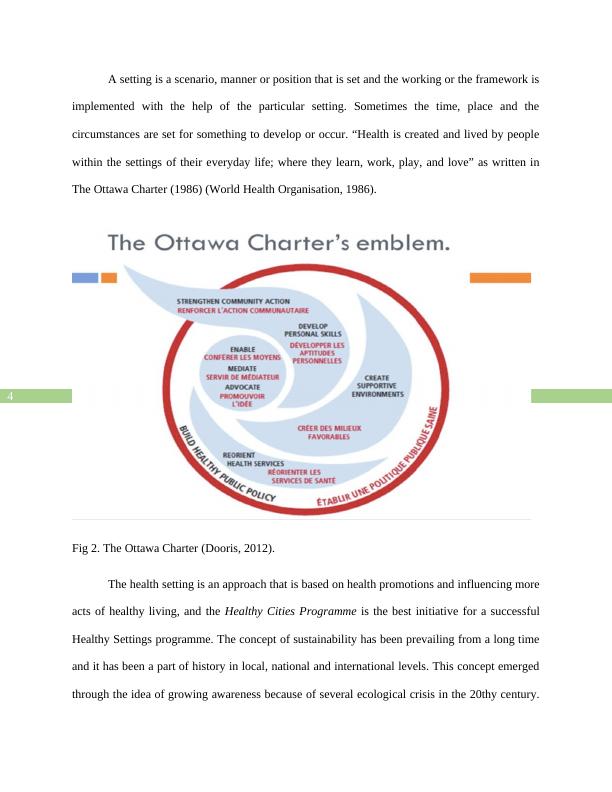
HEALTHY SETTINGS5
The roots of this concept is influenced by the longue duree approach that means ‘long term’, it
aims on events that happened over a long period of time, which is affected by the relation of
people and the world (Orme & Dooris, 2010). Global Health 2020 focuses on enhancing
costumer experiences, altering patient demographics, implementing new care models and
advanced technology that promises value based care (Poland, Krupa, and McCall, 2010).. Health
promotions have taken place in Ottawa and Jakarta by WHO, the 4th international conference on
health promotion known as New Players for a New Era is an ongoing health promotion in the
21st century. From 21 to 25 July in 1997, a meeting took place in Jakarta that was a critical
moment for the international strategies for global health. WHO’s member states made a
commitment to implement strategies for Health for All and the primary healthcare principles
after the declaration of Alma-Ata. In Ottawa, Canada, the first international conference on health
promotion took place 11 years back, this started the proclamation of Health Promotion for
Ottawa Charter (Dooris et al., 2018). These health promotions have been a guiding light for
implementing health strategies all around the world, it has its relevance and meaning for a health
promotion’s key strategies. Several milestones in health promotions have occurred due to the
corporation of WHO and the Geneva conference in 1954 opened many doorways for health
strategies all across the globe. It revolved around the armed violence and sustainable
development, it highlighted the role of the civil society in reducing the violence caused due to
social unrest, crime and war. The declaration was accepted in 2006 and it is followed by 113
states all around the world. The Geneva statement is strong and political, that focuses on the
impact of armed violence in the developmental context (Kickbusch, 2003). This was one of the
advances in the field of health promotion because it was aiming towards realizing the cost behind
armed violence, assessing the risks and vulnerability, prevention and reduction of violence
The roots of this concept is influenced by the longue duree approach that means ‘long term’, it
aims on events that happened over a long period of time, which is affected by the relation of
people and the world (Orme & Dooris, 2010). Global Health 2020 focuses on enhancing
costumer experiences, altering patient demographics, implementing new care models and
advanced technology that promises value based care (Poland, Krupa, and McCall, 2010).. Health
promotions have taken place in Ottawa and Jakarta by WHO, the 4th international conference on
health promotion known as New Players for a New Era is an ongoing health promotion in the
21st century. From 21 to 25 July in 1997, a meeting took place in Jakarta that was a critical
moment for the international strategies for global health. WHO’s member states made a
commitment to implement strategies for Health for All and the primary healthcare principles
after the declaration of Alma-Ata. In Ottawa, Canada, the first international conference on health
promotion took place 11 years back, this started the proclamation of Health Promotion for
Ottawa Charter (Dooris et al., 2018). These health promotions have been a guiding light for
implementing health strategies all around the world, it has its relevance and meaning for a health
promotion’s key strategies. Several milestones in health promotions have occurred due to the
corporation of WHO and the Geneva conference in 1954 opened many doorways for health
strategies all across the globe. It revolved around the armed violence and sustainable
development, it highlighted the role of the civil society in reducing the violence caused due to
social unrest, crime and war. The declaration was accepted in 2006 and it is followed by 113
states all around the world. The Geneva statement is strong and political, that focuses on the
impact of armed violence in the developmental context (Kickbusch, 2003). This was one of the
advances in the field of health promotion because it was aiming towards realizing the cost behind
armed violence, assessing the risks and vulnerability, prevention and reduction of violence
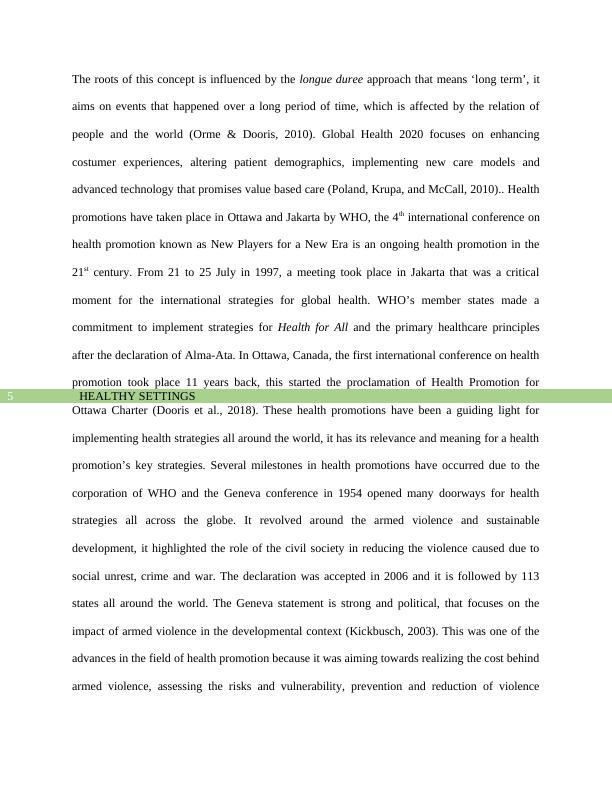
End of preview
Want to access all the pages? Upload your documents or become a member.
Related Documents
Health Promotionlg...
|14
|3138
|432
Green Architecture and Sustainability: A Visual Research Analysislg...
|17
|2269
|110
Important Resource Of Environmentlg...
|17
|3282
|30
Visual Research on Floral Theme for Sustainable Environmentlg...
|11
|1801
|80
Floral Theme for Sustainable Business Practices: A Visual Researchlg...
|18
|1977
|123
Building A Sustainable Organisationlg...
|9
|2720
|400
